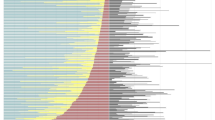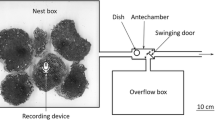Summary
We measured patterns of individual forager specialization and colony-wide rates of material input during periods of response to experimental nest damage and during control periods in three colonies of the tropical social wasp Polybia occidentalis.
-
(1)
Most foragers specialized on gathering a single material. While active, foragers rarely switched materials, and most switching that did occur was between functionally related materials — prey and nectar (food materials) or wood pulp and water (nest materials).
-
(2)
Individuals differed greatly in activity level, here expressed as rate of foraging. Workers that foraged at high rates specialized on a single material in almost all cases. Specialized, highly active foragers comprised a minority (about 33%) of the working foragers in each colony, yet provided most of the material input.
-
(3)
Individual wasps that responded to experimental nest damage by foraging for nest materials did not gather food on days preceding or following manipulation.
-
(4)
On the colony level, nectar and prey foraging rates were not affected by foraging effort allocated to nest repair within days, or when comparing control days with days when damage was imposed. The emergency foraging response to nest damage in P. occidentalis did not depend on effort recruited away from food foraging.
Similar content being viewed by others
References
Abraham M, Pasteels JM (1980) Social behaviour during nest-moving in the ant Myrmica rubra L. (Hym. Form.). Insectes Sociaux 27:127–147
Altmann J (1974) Observational study of behavior: sampling methods. Behaviour 49:227–265
Calabi P (1988) Behavioral flexibility in Hymenoptera: a re-examination of the concept of caste. In: Trager JC (ed) Advances in myrmecology. EJ Brill Press, Leiden, pp 237–258
Calabi P, Traniello JFA (1989) Social organization in the ant Pheidole dentata. Behav Ecol Sociobiol 24:69–78
Calabi P, Traniello JFA, Werner MH (1983) Age polyethism: its occurrence in the ant Pheidole hortensis, and some general considerations. Psyche 85:395–412
Colgan PW, Smith JT (1978) Multidimensional contingency table analysis. In: Colgan PW (ed) Quantitative ethology, chapter 6. Wiley, New York, pp 145–174
Eickwort GC, Ginsberg HS (1980) Foraging and mating behavior in Apoidea. Annu Rev Entomol 25:421–446
Forsyth AB (1978) Studies on the behavioral ecology of polygynous social wasps. PhD dissertation, Harvard University, Cambridge MA
Franks NR (1987) The organization of working teams in social insects. Trends Ecol Evol 2:72–75
Gordon DM (1984) The persistence of role in exterior workers of the harvester ant, Pogonomyrmex badius. Psyche 91:251–265
Gordon DM (1989a) Caste and change in social insects. In: Harvey PL, Partridge L (eds) Oxford surveys in evolutionary biology, vol 6. Oxford University Press, Oxford, pp 55–72
Gordon DM (1989b) Dynamics of task switching in harvester ants. Anim Behav 38:194–204
Heinrich B (1976) The foraging specializations of individual bumblebees. Ecol Monogr 46:105–128
Herbers JM (1980) On caste ratios in ant colonies: population responses to changing environments. Evolution 34:575–585
Herbers JM (1981) Reliability theory and foraging by ants. J Theor Biol 89:175–189
Hunt JH, Jeanne RL, Baker I, Grogan DE (1987) Nutrient dynamics of a swarm-founding social wasp species, Polybia occidentalis (Hymenoptera: Vespidae). Ethology 75:291–305
Jeanne RL (1986a) The evolution of the organization of work in social insects. Monitore Zool Ital 20:119–133
Jeanne RL (1986b) The organization of work in Polybia occidentalis: costs and benefits of specialization in a social wasp. Behav Ecol Sociobiol 19:333–341
Jeanne RL (1987) Do water foragers pace construction activity in Polybia occidentalis? Experientia Suppl 54:241–251
Jeanne RL, Downing HA, Post DC (1988) Age polyethism and individual variation in Polybia occidentalis, an advanced eusocial wasp. In: Jeanne RL (ed) Interindividual behavioral variability in social insects. Westview Press, Boulder, pp 323–357
Kolmes SA (1985a) An information theory analysis of task specialization among worker honey bees performing hive duties. Anim Behav 33:181–187
Kolmes SA (1985b) An ergonomic study of Apis mellifera (Hymenoptera: Apidae). J Kans Entomol Soc 58:413–421
Kolmes SA (1986) Have hymenopteran societies evolved to be ergonomically efficient? J N Y Entomol Soc 94:447–457
Lehner PN (1979) Handbook of ecological methods. Garland STPM Press, New York, p 277
Lenoir A, Ataya H (1982) Stochastic aspects of polyethism in the ant Lasius niger. In: Breed MD, Michener CD, Evans HE (eds) The biology of social insects. Boulder, Westview Press, p 252
Oster GF, Wilson EO (1978) Caste and ecology in the social insects. Princeton University Press, Princeton
Plowright RC, Plowright CMS (1988) Elitism in social insects: a positive feedback model. In: Jeanne RL (ed) Interindividual behavioral variability in social insects. Westview Press, Boulder, pp 419–431
Rissing SW (1981) Foraging specializations of individual seed-harvester ants. Behav Ecol Sociobiol 9:149–152
Schmid-Hempel P (1984) Individually different foraging methods in the desert ant Cataglyphis bicolor (Hymenoptera, Formicidae). Behav Ecol Sociobiol 14:263–271
Seeley TD (1982) Adaptive significance of the age polyethism schedule in honeybee colonies. Behav Ecol Sociobiol 11:287–293
Steinberg JB (1977) Information theory as an ethological tool. In: Hazlett BA (ed) Quantitative methods in the study of animal behavior. Academic Press, New York, pp 47–74
Verron H (1981) Polyethism and population genetics. In: Howse PE, Clement JL (eds) Biosystematics of social insects. Academic Press, London, pp 289–295
Wilson EO (1971) The insect societies. Harvard University Press, Cambridge MA
Wilson EO (1983) Caste and division of labor in leaf-cutter ants (Hymenoptera: Formicidae: Atta) III. Ergonomic resiliency in foraging by A. cephalotes. Behav Feel Sociobiol 14:47–54
Wilson EO (1984) The relation between caste ratios and division of labor in the ant genus Pheidole (Hymenoptera: Formicidae) Behav Ecol Sociobiol 16:89–98
Winston ML, Fergusson LA (1985) The effect of worker loss on temporal caste structure in colonies of the honeybee (Apis mellifera L.). Can J Zool 63:777–780
Author information
Authors and Affiliations
Additional information
Offprint requests to: S. O'Donnell
Rights and permissions
About this article
Cite this article
O'Donnell, S., Jeanne, R.L. Forager specialization and the control of nest repair in Polybia occidentalis Olivier (Hymenoptera : Vespidae). Behav Ecol Sociobiol 27, 359–364 (1990). https://doi.org/10.1007/BF00164007
Received:
Accepted:
Issue Date:
DOI: https://doi.org/10.1007/BF00164007




